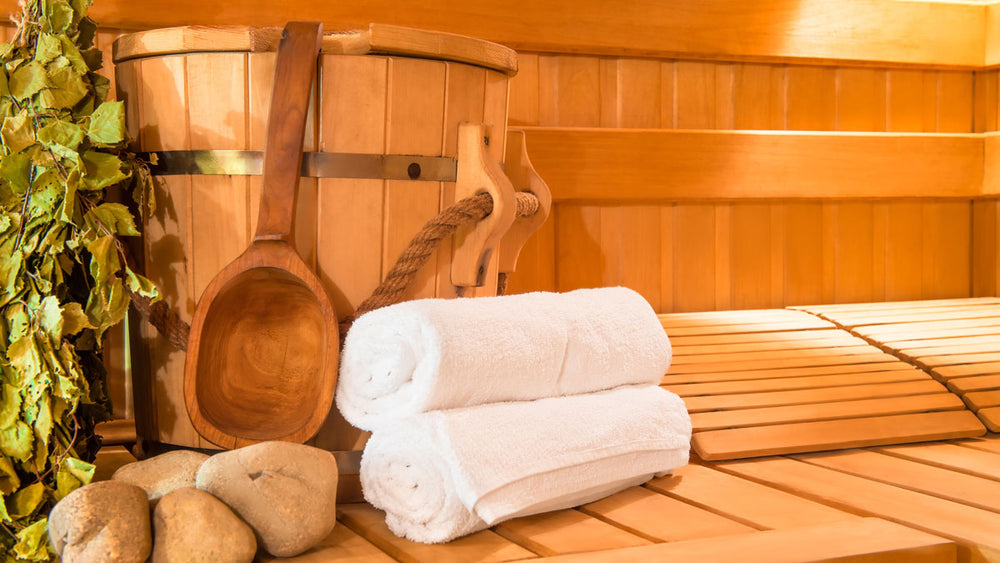Who doesn’t like to soak in a hot tub?
Historically people have gravitated to warmth. Whether it is immersing oneself in warm water, cuddling up in warm blankets, or relaxing in a sauna – these activities are hugely popular. And I didn’t even mention sunbathing. People have historically enjoyed the benefits of heating up their bodies. It feels good, and it appears to be good for us in several notable ways!
Evidence for Effectiveness
Here are some of the most well-documented, powerful benefits of regularly warming the body, either through warm water immersion or the use of dry saunas:
Better Circulation- Even short-term (5 min) warm water immersion can substantially reduce heart rate, lower blood pressure, and decrease vascular resistance. These improvements in circulation are so profound that there is some evidence that soaking in warm (but not cold) water for 30 min immediately after 30 min exercise yields similar improvements in maximum oxygen consumption and glucose metabolism as performing 60 minutes of continuous exercise.
Regular use of saunas is associated with lower blood pressure and reduced arterial stiffness, which has profound health implications. Sauna use has also been related to improvements in blood cholesterol. Given the importance of circulation towards overall health, the measurable improvements in circulation from warmth therapy are likely the mechanism to explain the following documented effects.
Reduced Heart Disease- Heart disease is still the number one killer. Reducing arterial stiffness and blood pressure, as warmth therapy does, should reduce one’s risk of heart disease. Some good evidence out of Finland, where sauna use is a popular cultural pastime, supports regular sauna use with a reduced risk of sudden cardiac death, fatal coronary heart disease, cardiovascular disease, and all-cause mortality.
Reduced Lung Disease- Regular sauna use has been used as a therapy to reduce symptoms of respiratory disease. Patients with lung disease can transiently improve lung function, increasing their ability to expire air quickly after sauna use.
Reduced Risk of Dementia- Dementia, including Alzheimer’s disease, is a devastating terminal illness that afflicts over 50 million people worldwide. Regular sauna bathing has been associated with a significant reduction in risk for both dementia and Alzheimer’s disease, with risk reduction noted with 2-3 sauna sessions/week and a greater risk reduction noted with higher (4-7 sessions) frequency.
The Bottom Line
Looks like warming up your body regularly is a good idea. The time investment does not need to be great; Finnish data indicate a few (say 3) sessions of 5-20 min in duration per week is sufficient to enjoy a reduced risk of cardiovascular events. Most of the best data come from studies of sauna bathing due to its prevalence in Finnish culture. Whether soaking in a hot tub would confer the same benefits is unknown, but given that the increase in core temperature is the main mechanism documented to the circulation-altering benefits that underpin the documented health benefits, it seems unlikely to matter whether you stay wet or dry (sweating aside).
Heat therapy might not be for everyone. Specifically, people prone to hypotension (low blood pressure), where the risk of fainting during a session is high, should avoid this particular therapy. And it is always a good idea to check with your physician before you institute any marked changes in your health regimen.
- Cox, N. J., Oostendorp, G. M., Folgering, H. T., & van Herwaarden, C. L. (1989). Sauna to transiently improve pulmonary function in patients with obstructive lung disease. Archives of physical medicine and rehabilitation, 70(13), 911–913.
- Gryka, D., Pilch, W., Szarek, M., Szygula, Z., & Tota, Ł. (2014). The effect of sauna bathing on lipid profile in young, physically active, male subjects. International journal of occupational medicine and environmental health, 27(4), 608–618.
- Heinonen, I., & Laukkanen, J. A. (2018). Effects of heat and cold on health, with special reference to Finnish sauna bathing. American journal of physiology. Regulatory, integrative and comparative physiology, 314(5), R629–R638.
- Laitinen, L. A., Lindqvist, A., & Heino, M. (1988). Lungs and ventilation in sauna. Annals of clinical research, 20(4), 244–248.
- Laukkanen, T., Khan, H., Zaccardi, F., & Laukkanen, J. A. (2015). Association between sauna bathing and fatal cardiovascular and all-cause mortality events. JAMA internal medicine, 175(4), 542–548.
- Laukkanen, T., Kunutsor, S., Kauhanen, J., & Laukkanen, J. A. (2017). Sauna bathing is inversely associated with dementia and Alzheimer's disease in middle-aged Finnish men. Age and ageing, 46(2), 245–249.
- Russell, B. M., Chang, C. R., Hill, T., Cotter, J. D., & Francois, M. E. (2021). Post-exercise Warm or Cold Water Immersion to Augment the Cardiometabolic Benefits of Exercise Training: A Proof of Concept Trial. Frontiers in physiology, 12, 759240.
- Sugawara, J., & Tomoto, T. (2021). Acute Effects of Short-Term Warm Water Immersion on Arterial Stiffness and Central Hemodynamics. Frontiers in physiology, 12, 620201.



















Comments
Join The Conversation...